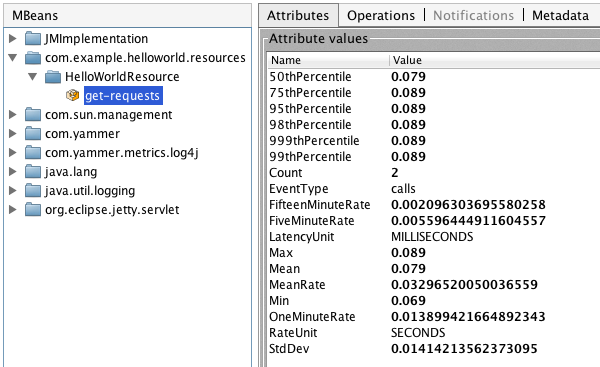Getting Started will guide you through the process of adding Metrics to an existing application. We’ll go through the various measuring instruments that Metrics provides, how to use them, and when they’ll come in handy.
Just add the metrics-core library as a dependency:
<dependencies>
<dependency>
<groupId>com.yammer.metrics</groupId>
<artifactId>metrics-core</artifactId>
<version>2.1.5</version>
</dependency>
</dependencies>
Now it’s time to add some metrics to your application!
A gauge is an instantaneous measurement of a value. For example, we may want to measure the number of pending jobs in a queue:
Metrics.newGauge(QueueManager.class, "pending-jobs", new Gauge<Integer>() {
@Override
public Integer value() {
return queue.size();
}
});
Every time this gauge is measured, it will return the number of jobs in the queue.
For most queue and queue-like structures, you won’t want to simply return queue.size(). Most of java.util and java.util.concurrent have implementations of #size() which are O(n), which means your gauge will be slow (potentially while holding a lock).
A counter is just a gauge for an AtomicLong instance. You can increment or decrement its value. For example, we may want a more efficient way of measuring the pending job in a queue:
private final Counter pendingJobs = Metrics.newCounter(QueueManager.class, "pending-jobs");
public void addJob(Job job) {
pendingJobs.inc();
queue.offer(job);
}
public Job takeJob() {
pendingJobs.dec();
return queue.take();
}
Every time this counter is measured, it will return the number of jobs in the queue.
A meter measures the rate of events over time (e.g., “requests per second”). In addition to the mean rate, meters also track 1-, 5-, and 15-minute moving averages.
private final Meter requests = Metrics.newMeter(RequestHandler.class, "requests", "requests", TimeUnit.SECONDS);
public void handleRequest(Request request, Response response) {
requests.mark();
// etc
}
This meter will measure the rate of requests in requests per second.
A histogram measures the statistical distribution of values in a stream of data. In addition to minimum, maximum, mean, etc., it also measures median, 75th, 90th, 95th, 98th, 99th, and 99.9th percentiles.
private final Histogram responseSizes = Metrics.newHistogram(RequestHandler.class, "response-sizes");
public void handleRequest(Request request, Response response) {
// etc
responseSizes.update(response.getContent().length);
}
This histogram will measure the size of responses in bytes.
A timer measures both the rate that a particular piece of code is called and the distribution of its duration.
private final Timer responses = Metrics.newTimer(RequestHandler.class, "responses", TimeUnit.MILLISECONDS, TimeUnit.SECONDS);
public String handleRequest(Request request, Response response) {
final TimerContext context = responses.time();
try {
// etc;
return "OK";
} finally {
context.stop();
}
}
This timer will measure the amount of time it takes to process each request in milliseconds and provide a rate of requests in requests per second.
Metrics also has the ability to centralize your service’s health checks. First, implement a HealthCheck instance:
import com.yammer.metrics.core.HealthCheck.Result;
public class DatabaseHealthCheck extends HealthCheck {
private final Database database;
public DatabaseHealthCheck(Database database) {
super("database");
this.database = database;
}
@Override
public Result check() throws Exception {
if (database.isConnected()) {
return Result.healthy();
} else {
return Result.unhealthy("Cannot connect to " + database.getUrl());
}
}
}
Then register an instance of it with Metrics:
HealthChecks.register(new DatabaseHealthCheck(database));
To run all of the registered health checks:
final Map<String, Result> results = HealthChecks.runHealthChecks();
for (Entry<String, Result> entry : results.entrySet()) {
if (entry.getValue().isHealthy()) {
System.out.println(entry.getKey() + " is healthy");
} else {
System.err.println(entry.getKey() + " is UNHEALTHY: " + entry.getValue().getMessage());
final Throwable e = entry.getValue().getError();
if (e != null) {
e.printStackTrace();
}
}
}
Metrics comes with a pre-built health check: DeadlockHealthCheck, which uses Java 1.6’s built-in thread deadlock detection to determine if any threads are deadlocked.
All metrics are visible via JConsole or VisualVM (if you install the JConsole plugin):

Tip
If you double-click any of the metric properties, VisualVM will start graphing the data for that property. Sweet, eh?
Metrics also ships with a servlet (AdminServlet) which will serve a JSON representation of all registered metrics. It will also run health checks, print out a thread dump, and provide a simple “ping” response for load-balancers. (It also has single servlets–MetricsServlet, HealthCheckServlet, ThreadDumpServlet, and PingServlet–which do these individual tasks.)
To use this servlet, include the metrics-servlet module as a dependency:
<dependency>
<groupId>com.yammer.metrics</groupId>
<artifactId>metrics-servlet</artifactId>
<version>2.1.5</version>
</dependency>
From there on, you can map the servlet to whatever path you see fit.
In addition to JMX and HTTP, Metrics also has reporters for the following outputs: